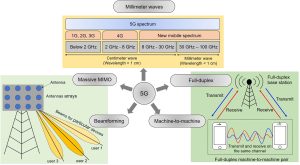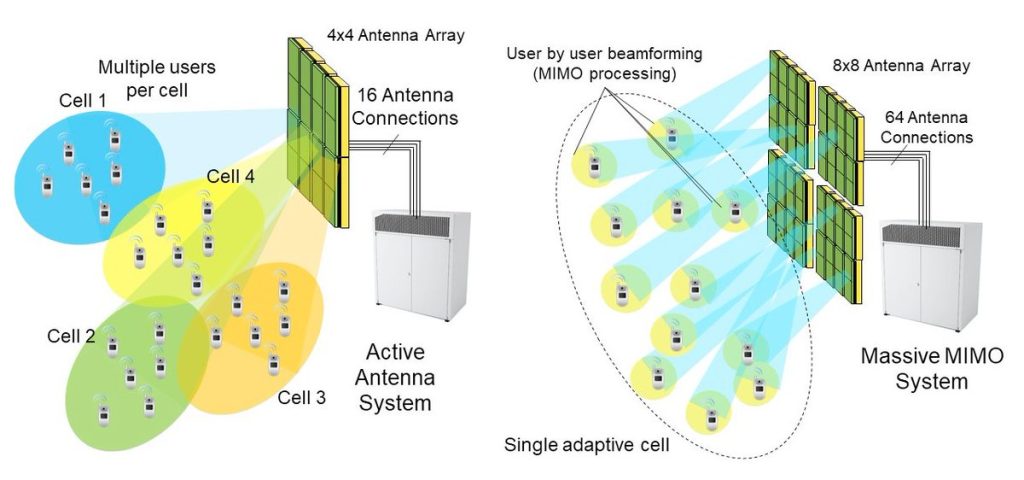The wireless communication industry has been revolutionized by beamforming, a perplexing technique that directs radio waves towards specific directions instead of broadcasting them in all directions. Despite its decades-long existence, beamforming has gained tremendous attention lately due to the emergence of 5G and massive MIMO systems that have brought about burstiness in communications.

Massive MIMO and beamforming are concepts closely intertwined with each other. Massive MIMO systems utilize multiple antennas to enhance network capacity and data rates in wireless networks while beamforming techniques help focus signals on particular devices or users, reducing interference and improving signal strength.
Antennas play an indispensable role when it comes to implementing beamforming techniques. They transmit and receive signals from different directions enabling precise control over the direction of radio waves. Patch antennas or dipole antennas can be used depending on the application at hand. In addition, digital beamforming is a popular choice due to its ability to adaptively adjust antenna patterns based on changing network conditions which adds another layer of perplexity into this already complicated concept.
Having a clear understanding of the fundamentals of beamforming in MIMO radio systems is crucial for anyone working within today’s wireless communication industry where burstiness reigns supreme. Signal processing techniques have advanced significantly over recent years resulting in higher data rates being achieved through massive MIMO and Beam-forming technologies than ever before possible! As we look ahead towards future trends like mmWave frequencies coupled with fixed networks continuous innovation will be required just so we can keep up with demand for faster speeds as well as greater connectivity worldwide!
How Massive MIMO and Beamforming Improve Wireless Communication
Contents
- 1 How Massive MIMO and Beamforming Improve Wireless Communication
- 2 The Role of Antennas in Beamforming Techniques
- 3 Digital vs Analog Beamforming: Which is Better for Your Wireless System?
- 4 The Benefits and Challenges of Hybrid Beamforming in Massive MIMO Systems
- 5 Signal Processing Techniques for Effective Beamforming in MIMO Antennas
- 6 The Application of Beamforming in Networks: Enhancing Data Rates and Capacity
- 7 Future Trends in Beamforming Systems for Wireless Communication: mmWave, Fixed Networks, and Beyond.
The wireless communication industry has been transformed by two technologies that have left everyone in a state of perplexity. Massive MIMO and beamforming are now essential for improving data rates and capacity, as the demand for high-speed internet connectivity continues to grow at an unprecedented rate.

Massive MIMO systems consist of a vast array of antennas working together simultaneously to transmit and receive signals with unparalleled burstiness. The use of smart antennas is another key feature that enables beamforming techniques to be applied, which directs radio waves towards specific targets, resulting in increased signal strength and quality.
While analog beamforming uses phase shifters to adjust the phase of each antenna element’s signal before they form an array pattern, digital beamforming employs complex algorithms that process signals from individual elements before combining them into an array pattern. Each method boasts unique benefits depending on the application; engineers must make careful considerations when choosing between these methods.
Wireless communication applications such as Wi-Fi beamforming and 5G networks have significantly improved due to the application of beamforming technology. By reducing interference levels between devices sharing network channels while increasing data rates and capacity, it is no surprise that digital beam forming will continue being used more often than traditional analogue methods ever could achieve alone – this makes future trends look promising!
The Role of Antennas in Beamforming Techniques
The enigmatic and perplexing world of wireless communication systems is a complex web of technologies that confound even the most astute engineers. Antennas, those elusive components that seem to defy explanation, hold the key to unlocking the full potential of beamforming techniques. In multiple input multiple output (MIMO) systems, spatial diversity is directly proportional to the number of antennas available for use. The more antennae there are in play, the greater data rate and capacity can be achieved by these networks.
Hybrid beamforming has emerged as an ingenious solution for MIMO systems due to its ability to reduce complexity while maintaining high levels of performance. A combination of analog and digital beamforming yields impressive results in this regard.
But let us not forget about receivers – they too have their part to play in this grand scheme. By processing signals from different transmit antennae, signal-to-noise ratio (SNR) increases exponentially. Signal processing algorithms further extract useful information from received signals while reducing interference caused by other users or base stations. And with multi-user MIMO extending beyond conventional boundaries for simultaneous transmission via varying beams; it’s no wonder why 5G networks rely heavily on beamforming technology.
As we look ahead towards future advancements within this field, one thing remains certain: antennas will continue playing an integral role in implementing effective beamforming techniques across wireless communication systems worldwide!
Digital vs Analog Beamforming: Which is Better for Your Wireless System?
The perplexing world of wireless communication systems is filled with an array of techniques, but none quite as bursty and mind-boggling as digital and analog beamforming. These two methods are vital for improving the performance of massive MIMO systems, where multiple antennas on both the transmitter and receiver ends work together to enhance signals.
It’s impossible to talk about Massive MIMO without mentioning beamforming – they’re like two peas in a pod! Beamforming enables better coverage, higher data rates, and improved capacity utilization by directing signals towards specific users or areas using advanced algorithms.
When it comes to beamforming itself, there are two flavors: digital and analog. Digital uses sophisticated signal processing techniques to control phase shifts at each antenna element individually. This allows for more precise directionality compared to analog which adjusts amplitude levels across all elements simultaneously. But beware – this extra precision comes at a cost with more expensive hardware.
So how do we choose between these two? It depends on what factors you prioritize; cost-effectiveness versus precision control over transmitted signals when using 5G base stations with narrowband beamformers. Regardless of your choice though – without some form of advanced signal processing like that provided by either method – even state-of-the-art Massive MIMO systems will not realize their full potential for enhancing data rates or capacity utilization within networks!
The Benefits and Challenges of Hybrid Beamforming in Massive MIMO Systems
The concept of hybrid beamforming is a perplexing technique that fuses both analog and digital beamforming to achieve optimal results. Its unique approach allows it to utilize fewer RF chains than conventional digital beamforming, resulting in cost-effective solutions while maintaining high performance. This is accomplished by utilizing an analog beamformer to shape the antenna pattern and then applying a digital beamformer for adjusting the antenna signals.
In massive MIMO systems, one of the key benefits of hybrid beamforming lies in its ability to support multiuser MIMO. By coordinating multiple beams towards each user’s direction, coordinated beamforming can serve different users simultaneously resulting in higher capacity and improved data rates for all within range.
However, challenges do exist with hybrid beamforming which require careful calibration of both analog and digital components for proper alignment between them. Furthermore, since this method uses both techniques together, it may require more complex hardware design compared to either method alone.
Despite these challenges though, the application of hybrid beamforming has shown remarkable results when used in wireless communication applications such as Wi-Fi and 5G networks. As technology continues its rapid advancement pace forward into new horizons, we can expect further developments in this area including improvements in signal processing techniques along with more sophisticated hardware designs leading to even better system performances from these types of systems bursting forth with innovation!
Signal Processing Techniques for Effective Beamforming in MIMO Antennas
The mysterious and complex world of modern wireless communication systems relies heavily on the enigmatic forces of adaptive beamforming. This awe-inspiring technique harnesses the power of multiple antennas to transmit signals towards their intended recipients, unleashing a burst of signal strength that reduces interference from unwanted sources. Without this unfathomable process, broadcast antenna systems would be helpless in meeting the data rates and capacity requirements demanded by 5G networks.
Digital antenna beamforming is a marvelously flexible and easy-to-implement scheme that has taken the industry by storm. Wi-Fi routers have embraced digital beamforming as an invaluable tool for improving network performance by directing signals towards connected devices. Analog beamforming, however, poses more significant challenges due to its need for dedicated hardware per antenna element – making it difficult to implement in large MIMO channels.
To achieve optimal results with this mind-boggling technology, signal processing techniques such as spatial filtering are employed. These elusive methods meticulously analyze received signals from multiple antennas while delicately adjusting phase and amplitude before combining them into one powerful output signal directed precisely at the receiver’s location. This allows for unparalleled control over transmitted signals’ directionality – making it indispensable when crafting 5G beamforming systems.
Beamforming is essential in facilitating high-speed wireless communication networks capable of supporting countless simultaneous users while keeping interference levels at bay! As technology continues to evolve rapidly with each passing day, we can expect new applications for this otherworldly technique beyond traditional fixed networks or mmWave frequencies currently being explored worldwide by researchers.
With its ability to enhance data rates significantly while minimizing interference levels considerably – industries such as telecommunications or transportation sectors where reliable connectivity is critical will undoubtedly continue exploring how best they can utilize this mesmerizing feature!
The Application of Beamforming in Networks: Enhancing Data Rates and Capacity
The perplexing and bursty world of wireless communication has been transformed by beamforming, an essential aspect that has significantly enhanced data rates and capacity in networks. This innovative technology is used to focus the transmission of radio signals towards a specific direction, resulting in reduced interference and improved signal strength.
Beamforming systems have evolved over time, from linear techniques in conventional MIMO systems to wideband systems operating at higher frequencies. The use of different strategies such as digital or analog can also impact network performance, while hybrid beamforming techniques have emerged as a promising solution for future wireless communication applications.
Exciting developments are on the horizon with mm-wave beamforming, which operates at extremely high frequencies offering significant benefits such as increased bandwidth and reduced latency. Additionally, fixed networks benefit from beamforming applications that enhance network coverage and improve overall system performance.
As we strive for higher data rates and greater capacity demands continue to grow exponentially, expect more mind-blowing innovations within the realm of mimo beamforming technology – it’s going to be one wild ride!
Future Trends in Beamforming Systems for Wireless Communication: mmWave, Fixed Networks, and Beyond.
As one peers into the future of wireless communication, it becomes evident that beamforming systems are taking on greater significance. The use of mmWave technology is an emerging trend that could leave a profound impact on this field. This approach involves utilizing frequencies surpassing 30 GHz, which can offer data rates far beyond those found in lower-frequency bands. By implementing beamforming techniques with these signals, there lies the potential to achieve even more significant gains in capacity and coverage.
Another vital development concerns fixed networks as opposed to relying solely on mobile devices for connecting directly to cellular networks. These systems entail installing stationary antennas at regular intervals throughout a given area; their subsequent signals can be combined and directed towards individual users when necessary. Such an approach serves to enhance signal quality while reducing interference – leading to superior end-user performance.
Lastly, there has been growing interest in employing massive MIMO technologies for optimal results with beamforming outcomes. These approaches necessitate using numerous antenna elements arranged into sets or arrays that may be dynamically adjusted based upon impinging signals. Through careful gain control of each antenna array and adjusting how antenna signals are altered per set of elements through digital or analog means, substantial improvements in both capacity and coverage for 5G connections become possible.
When considering all these factors together, it is quite apparent that beamforming will continue playing a critical role in shaping the future of wireless communication around the world. Whether by leveraging existing infrastructure more effectively via fixed networks or embracing new advancements such as mmWave technology – exciting possibilities lie ahead for this powerful technique!


